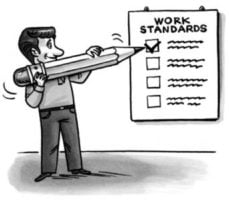Training Within Industry is a teaching methodology in the use of standard procedures developed for the American industry during World War II. TWI divides the training into four steps:
STEP 1
- Create relaxed learning atmosphere
- Identify work to be performed
- Find out what the student knows about this job
- Get the student interested in the work she will learn
- Set the student in the correct position to observe the job
STEP 2
- Describe and demonstrate each Main Step within the procedure
- Describe and demonstrate each Main Step while highlighting Key Points within each step
- Describe and demonstrate each Main Step with Key Points, and explain why they are so important
- Instruct clearly, completely and carefully
- Do not give the student more information than she is able to assimilate
STEP 3
- The student does the job – correct her mistakes during the process
- The student performs the job again and names Main Steps
- The student performs the job again and explains Key Points
- The student performs the job again and explains reasons for Key Points
- Continue until you can be sure that the student understands
STEP 4
- Leave the student alone with the task
- Explain whom she can turn to for help
- Check on progress frequently
- Encourage to ask questions
- Gradually reduce supervision
Implementation Steps
Definition of a Standard
Standard is the best, safest, easiest, simplest and most reliable way to perform a job. As such, it is only known to people who do the work. Standards should contain information on external and internal customers’ requirements: quantity, quality, and time. It is important to make sure that there exists only one standard for any activity.
Standards are used for:
- Ensuring that best practices remain in house
- Training of new associates
- Problem solving
- Control over execution of work
- Continuous improvement
Not all operations require standards. Where activities are repetitive, standards should exist throughout. However, where the work is creative or highly skilled, standards will be more difficult to implement. Nevertheless, it will be desirable to standardize at least thinking blocks.
Standard YES
- An operation must be performed in the same way each time
- Work is not performed by experts
- Quality, cost and productivity are important
- It is desirable to keep best practices in house
Standard NOT NECESSARILY
- Work is creative
- Work is constantly changing
- Large amount of experience is required to carry out work
- Work is only performed by highly skilled experts
TWI Workshop
The class teaches TWI methodology and implementation of standard work. Participants practice developing standards and training in their use during simulation games. Part of the training also creates initial standards in the pilot area and develops a training plan.
Agenda
DAY 1
- Review philosophy of Lean Management, history of TWI, foundations of standard work
- Standard Work Simulation – developing Standard Operating Procedure (SOP) based on SDCA (Standardize-Do-Check-Act) and working according to standards
- TWI methodology – training in the use of standards in 4 steps
- Job Breakdown Sheet (JBS) – standardization of training
- TWI simulation – training in and auditing the use of standards
- Standard work audit, Kamishibai board
DAY 2
- Develop sample standards in the pilot area and create a plan to train in their use
- Skill Matrix – visual management of skill levels of employees
- Implementing TWI in the organization, TWI trainers
- Overview of the other TWI modules – Jobs Methods, Jobs, Training, Program Development, Safety, Problem Solving
- Quiz


